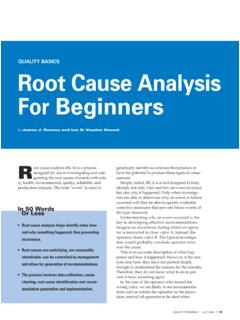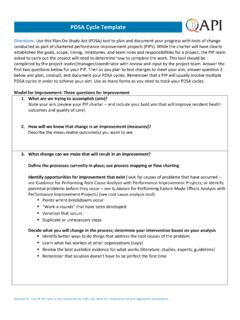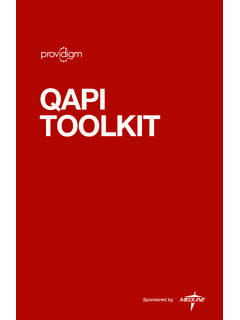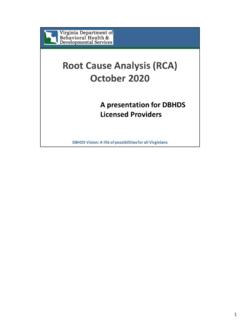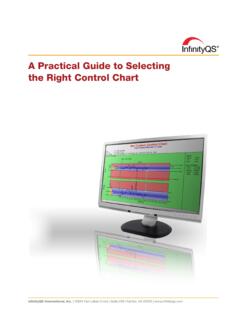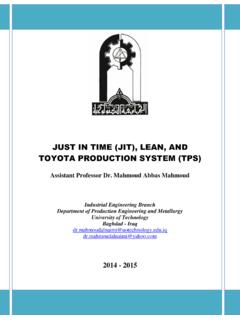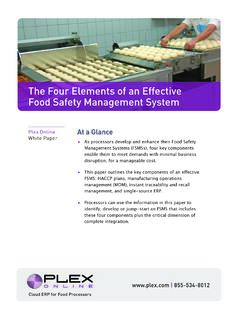Transcription of Corrective/Preventive Action and Root Cause/Data Analysis ...
1 Corrective/Preventive Action and root Cause/Data Analysis Seminar Olga Ceritelli Senior Program Manager, Show Me Quality Consulting (323) 896-2861. 1. Learning Objectives Help you get the most out of your corrective actions and ensuring corrective Action responses meet requirements. Strengthen your understanding of the root cause Analysis process Clarify the difference between Corrective and Preventive Actions o Highlight areas to leverage off of to identify opportunities for preventive Action Emphasize the importance of data Analysis , ensuring your data Analysis efforts are value-added and how to utilize your data Analysis in preventive actions. Clarify how this all works as a system. 2. Overview Time Activity 9:00 9:15 am Introductions 9:15-10:15 am Opening Discussion/Participant Input Audit Value and Momentum Corrective Action CA Challenges CA Components Typical CA Process Flow Importance of CAs Preventive Action Data Analysis GSFC CA/PA Process 10:15-10:30 Break 3.
2 Overview (Cont'd). Time Activity 10:30 10:50 am CA Exercise: Work in Groups 10:50 11:15 am CA Exercise Presentations 11:15 11:45 am EaglePicher presentation by Forrest Reed: A supplier's story of improving corrective actions. 11:45 am noon Wrap-up Discussion 4. Audit Value and Momentum 5. Audit Value and Momentum Much of the audit value occurs prior to the arrival of the audit team in the efforts the organization puts into preparing for the audit. Audits often result in the identification of issues that require attention. o Too often audits result in a frenzy of activity to respond to the audit with band aide fixes or worse, no real activity. o This is where a strong corrective Action program is critical! Don't let the process end when the band aide is put on. 6. Audit Value and Momentum Do you think your organization/audit program is capitalizing on the momentum gained and the increased management attention resulting from the audit?
3 O At the time of the outbrief, there is a lot of management and organizational attention on the noncompliances. o Often audit timelines result in losing the momentum that results from audits. 7. Corrective Action 8. CA Challenges Not bringing in the right group Problem not well defined Focusing on people or retraining only Culture Not truly understanding the problem or its cause Lack of containment actions Stopping at Quick Fixes Management Commitment Resource Balancing Impact/Scope not understood 9. CA Challenges (Cont.). Example GSFC Supply Chain Findings Related to Corrective/Preventive Action Process Supplier's Corrective Preventive Action Request form does not identify criteria for root cause Analysis . Determination and implementation of Action taken by Supplier do not effectively provide root cause Analysis or corrective and preventive actions.
4 Repeat finding from 2009 Card #'s 12 & 13. Open Corrective Action Requests are averaging 180 days since inception, which violates industry and internal requirements for timely closure of corrective actions. The root cause corrective Action system is not effectively addressing the many QMS performance parameters and the many corrective actions that are past due (Reissue of 2011 Finding NC-014). Eight (8) of the fifteen (15) findings from the NASA June 2011 assessment had not been resolved. Corrective Actions are not timely because the average delinquent corrective Action is currently days. (repeat of Card #020 from the OCT 2011 assessment). No evidence of the incorporation of identified lessons learned into applicable work processes. There is no process in place to perform EEE Part Failure Analysis Failure Analysis Report was approved as closed with no evidence that a review of the effectiveness of the corrective actions taken was done.
5 Corrective and Preventive Action processes are not effectively implemented. Four nonconformance reports were randomly sampled and none included root cause Analysis or planned corrective Action . 10. CA Challenges (Cont.). Many corrective Action responses to audit findings do not address: o How the process failure was addressed (some focus only on a nonconforming product identified) (reference AS9100C & ISO 9001:2008. ). o What was specifically done to address the nonconforming product identified (some only focus on the process and forget to address the nonconforming product identified) (reference AS9100C & ISO 9001:2008 ). o Looking across the organization for other areas where the nonconformity may occur and applying preventive actions in those areas (AS9100C & ISO. 9001:2008 ). 11. CA Components CA Response Components o Immediate Action o root Cause Analysis root Cause Tools and Methods o Scope Investigation o Corrective Actions - Fix Cause(s).
6 O Evaluation of Effectiveness 12. CA Components (Cont.). Immediate Action (remedial, containment Action ). The Action planned or taken to correct the specific individual problem or condition that was found to be a nonconformity. o For example, immediate Action a supplier might take if expired Inspection, Measuring and Test Equipment (IM&TE) were identified in their testing lab would be to remove the IM&TE from use (segregate/turn in to Cal lab/etc.). Should include actions required to contain the immediate problem. May include notification of the customer or others potentially affected as appropriate. 13. CA Components (Cont.). root Cause Analysis root Cause Analysis : Defined analytical method(s) employed to identify and understand the cause(s) of an undesired outcome or nonconformance in order to formulate appropriate corrective Action (s) that will prevent the recurrence of the undesired outcome or nonconformance throughout the organization.
7 root cause Analysis is used also to identify and understand the cause(s) of a potential undesired outcome or nonconformance in order to formulate appropriate preventive Action (s) that will prevent the occurrence of the undesired outcome or nonconformance throughout the organization. In addition, root cause Analysis is used to determine if the cause(s) and associated real or potential undesired outcome or nonconformance are isolated or systemic root Cause(s): events, factors or conditions that if eliminated or sufficiently mitigated through appropriate Action (s) would prevent the recurrence or potential occurrence of an undesired outcome or nonconformance throughout the organization. 14. CA Components (Cont.). root Cause Analysis o root Cause Analysis efforts on flight project problems frequently do not go far enough to expose root cause(s).
8 O Often the underlying organizational factors of a problem ( training, process, infrastructure, etc.) are not addressed 15. CA Components (Cont.). root Cause Analysis There are numerous problem and cause Analysis tools available to apply to problems o What tool/method should you apply? Action Decision Table Change Analysis /No Problem Comparison 8 Discipline (8D) Problem Solving Events and Causal Charting Failure Mode Effect Analysis Fault Tree Analysis /Causal Tree Fishbone Diagram Storytelling/Analogy 5 Why? Other? o When conducting CA, do you ensure you have someone involved that is competent in CA and the CA models used within your organization? 16. CA Components (Cont.). root Cause Tools and Techniques: 5 Why Asks the question ..enough times to find the root cause(s). In the course of asking why, you will find many causes .
9 17. CA Components (Cont.). root Cause Tools and Techniques: 5 Why 5 Why helps to turn the Undesired Outcome into an Event Question o An Event Question should be: Short Simple Concise Focused on One Problem o An Event Question does not: Tell what caused the event State what to do next If you cannot say it simply, you do not understand the problem . 18. - Albert Einstein CA Components (Cont.). root Cause Tools and Techniques: 5 Why The Event Question: Why did the window break? Not: Who threw that baseball? OR Don't give the bat to Timmy The Event Question: Why was the Test Equipment calibration label exceeding its due date? Not: Who owns this Test Equipment? 19. CA Components (Cont.). root Cause Tools and Techniques: 5 Why There could be more than one Why path Why is CA not timely? It takes two weeks to assign it to the managers once issued Why is it taking to weeks to assign it to Managers Managers are provided six months to respond Why are managers given 6 months to respond?
10 20. CA Components (Cont.). root Cause Tools and Techniques: 5 Why o Data Collection - Items to be considered: Location (Where). Names (Who). Roles/Functions Time (When). Conditions (operating/environmental). Instructions (How). Equipment Physical Evidence Recent Process Changes Degree of Training 21. CA Components (Cont.). root Cause Tools and Techniques: 5 Why o Don't forget to ask .what role did organizational factors play? Policies and Procedures Resource constraints Processes Infrastructure Systems Operating Instructions Training Management Processes Culture Others . 22. CA Components (Cont.). root Cause Tools and Techniques: Fishbone Diagram Materials Methods Why? Why? Why? Why? Why? Why? Corrective UndesiredAction Personnel Process is not Timely Outcome Why?responding not Primary competent in CA. Cause Why?
